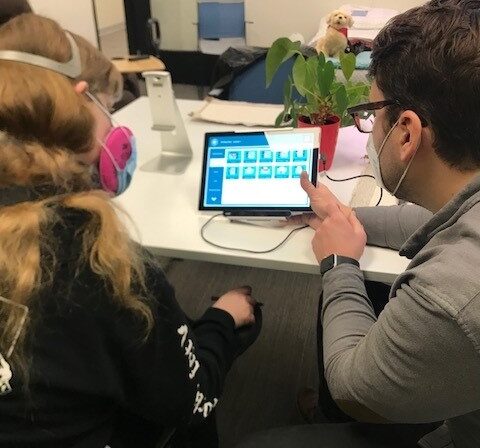As a multimodal communicating adult with autism, Saoirse relies on assistive technology to communicate with others. But for many years, Saoirse was limited to technology that was difficult to use and made it hard for her to feel fully included.
Kathy Callahan, an Adult Autism Specialist at Northeast Arc’s Adult Autism Support Center, noticed the difficulty Saoirse was having during a cooking class at the Center for Linking Lives. At the time, Saoirse was using a device required that required her to manually tap a screen and choose her words.
“I noticed in the cooking class, if she wanted to communicate or ask questions, she had to stop what she was doing, wash her hands, pick up the device, type, hit ‘play the message,’ wait to ensure others understand what she said. Many times she had to repeat, retype, and play it again to make sure she was understood, all before she was able to get back to the task at hand,” said Callahan. “[It was a] really lengthy process for her and she could not be integrated into the class like everybody else.”
Saoirse experiences seizures and often has motor control and coordination issues, so the physical nature of the tap device made it difficult for her to communicate if she was not able to control her hands, or if she was exhausted following a seizure.
The delayed nature of the tap device also proved to be a challenge when communicating with other individuals on the autism spectrum.
“[For individuals with autism] reciprocal communication can be difficult anyway,” said Sarah Wilsey, Director of Adult Support Centers at Northeast Arc. “So, if a peer is standing there and has to wait as she types, it would be a challenge for some of her peers who wouldn’t know what to do in that gap.”
Callahan realized that Saoirse had never undergone a formal assistive technology evaluation to assess her needs and match her with the appropriate equipment. That’s when she reached out to Jeff Boucher, Northeast Arc’s assistive technology coordinator. Boucher had technology in mind, but first Saoirse needed to undergo an assessment to ensure that the device would be a match, and that the cost of it would be covered.
The assessment – known as an augmentative and alternative communication evaluation – took place at Peer Projects in Beverly. Evaluators Kris Desmarais and Linda Murphy determined that an eye gaze device would be a good fit for Saoirse.
With Boucher’s help, Saoirse was able to obtain a Tobii Dynavox EM-12 with PCEye technology. This combination of software and hardware allows Saoirse to control a tablet computer with just her eyes, giving her added flexibility in how she communicates.
“It’s easier for her to use, but it’s also easier for the people she’s communicating with,” said Boucher, who has spent hours working with Saoirse to make sure the eye gaze device is optimized for her communication style. “It makes communicating a lot more natural for her. It’s less artificial.”
For Saoirse, the new device has not just meant improved communication, but improved accessibility and inclusion with her peers and the community.
“When I’m doing things where my hands are busy, like eating, I don’t have to pause mid-meal, pick up my tablet, and [use] my screen to be part of discussions,” wrote Saoirse in an email. “I was [also] able to attend virtual appointments when I had COVID-19 and be clearly heard and understood by the doctor. I was able to get info about medicine and treatment options.”
Because of the process initiated by Callahan, Saoirse’s device was covered by a combination of insurance and funding from the Massachusetts Department of Developmental Services (DDS).
“The eye gaze technology has absolutely changed her life and has made her a more confident and comfortable communicator,” said Jodi Smith, Service Coordinator Supervisor for DDS. She cited how Callahan, Wilsey, and Boucher worked to make sure Saoirse had a device optimized for her needs. “Northeast Arc has maintained contact and support for her and are now adding stands for her device so she can communicate when lying down, after a seizure or when sitting or standing.”
For Callahan, this monthslong process really highlighted the importance of collaboration with agencies outside the Northeast Arc.
“For it to come to fruition, we needed every single person that was involved,” said Callahan.
Wilsey said the process of working with Saoirse provides a blueprint for how Northeast Arc can use assistive technology to support others.
“What we try to do in general in the Adult Autism Support Center, is make connections [to promote independence],” said Wilsey. “You look at somebody’s life and where their strengths are and where the gaps in services are. And we refer, first within the agency if we have an applicable program, and then to supports throughout their communities. It’s all with the goal of helping people flourish in their everyday lives.”
